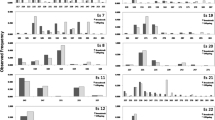Abstract:
In aquaculture, microsatellite DNA markers are used to genotype parental broodstock, to assess fertilization success, and to maintain pedigree information for selective breeding. In this study we genotyped individual Haliotis asinina larvae by analyzing a suit of polymorphic microsatellite loci. At least 10 loci can be analyzed from a single abalone veliger larva. We assayed 5 polymorphic loci to identify the parents of individual larvae produced in 3 separate crosses. In all cases, the parents of an individual veliger could be determined from as few as 3 loci. The microsatellite analysis revealed that, in each of our crosses, a single male fathered most of the veligers, despite efforts to normalize the amount of sperm contributed by competing males. These observations suggest that highly controlled breeding practices may be required to ensure that the genetic diversity of an abalone population produced for aquaculture is maintained at the level of diversity of the original broodstock.
Similar content being viewed by others
Author information
Authors and Affiliations
Additional information
Received December 4, 2000; accepted May 22, 2001.
Rights and permissions
About this article
Cite this article
Selvamani, M., Degnan, S. & Degnan, B. Microsatellite Genotyping of Individual Abalone Larvae: Parentage Assignment in Aquaculture. Mar. Biotechnol. 3, 478–485 (2001). https://doi.org/10.1007/s1012601-0062-X
Issue Date:
DOI: https://doi.org/10.1007/s1012601-0062-X




